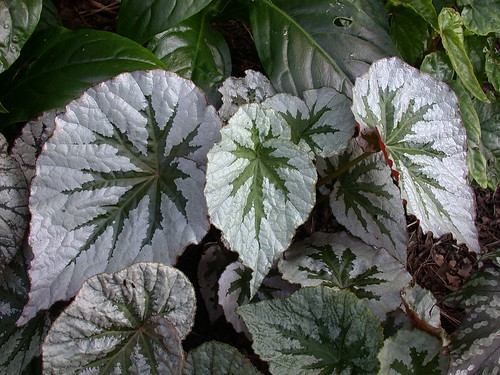
Unnamed begonia hybrid, a heartbreaking beauty (June 2012)
I hope to (eventually) blog about some of my successes with begonia breeding, but for now I'm going to describe one of my failures. The plant in the above photo is one of my own hybrids, photographed in my garden in June 2012, from a cross I made in 2011. I call it a "beautiful failure" because it ultimately failed several critical tests, and as of 2013 I'm no longer growing it at all.
The seed parent of this hybrid was Begonia grandis. Begonia grandis is commonly known as the "hardy begonia"; its primary claim to fame is hardiness, but as begonias go, it's rather drab. I've been crossing this species with numerous other begonias in an attempt to get its hardiness into hybrids with more interesting foliage.
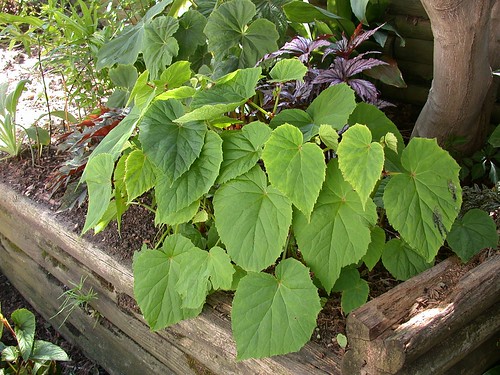
Begonia grandis 'Early Bird', an early-blooming selection of the species
The pollen parent was Begonia U489. This is a plant of somewhat mysterious origin, known only from cultivation. The "U" designation refers to a numbering system used for unidentified begonias by the American Begonia Society. U489 supposedly comes from Vietnam, but was probably purchased in a market. It is not any species that I can identify and seems to be a rex hybrid; its large, silvery sea-green leaves with a small deep green splotch in the center are very distinctive. Most promising for my purposes is that it is fairly hardy, and has survived two (mild) winters in my own garden with only a light mulch for protection.
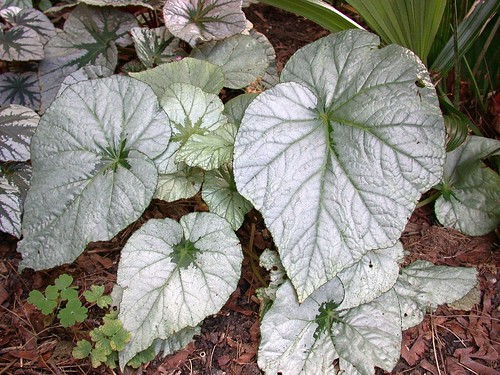
Begonia U489
I made the cross in summer 2011, sowing the seeds that fall and growing the seedlings under fluorescent lights over the winter. The first hint that I might have something interesting came when some of the seedlings began to show distinct silvery markings at a very early age. This also told me that I hadn't accidentally self-pollinated B. grandis. As they grew and more of the seedlings started to show interesting leaf patterns, I became more and more anxious to see the hybrids grow to maturity. Plant breeding is a rather odd hobby for somebody with as little patience as I have!

Seedling of B. grandis × U489 showing its first markings

Seedlings of B. grandis × U489
I ended up with a huge amount of variation from this cross, a strong indication that U489 is probably a hybrid rather than a species, which would produce a more uniform F1 generation. Out of several hundred tiny seedlings that I screened for interesting leaf markings, I eventually saved and grew on about two dozen of the best. The leaf patterns fell into two broad types: one group with a broad silvery margin and central green splotch, somewhat like U489, and the other group with silver speckles and splotches quite unlike U489. I planted the seedlings in my garden in early May, and as they grew they just kept getting better and better. By June I was convinced I had some real winners on my hands. One seedling in particular stood out for its large leaves and bold pattern.
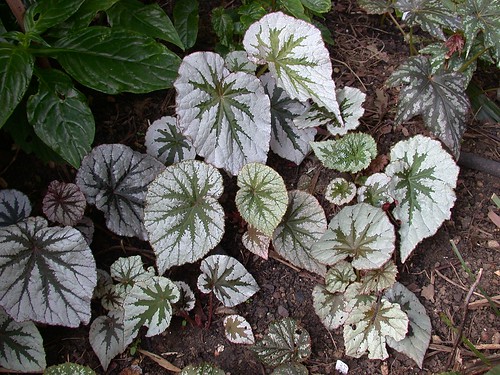
B. grandis × U489 seedlings in the garden (May 2012)
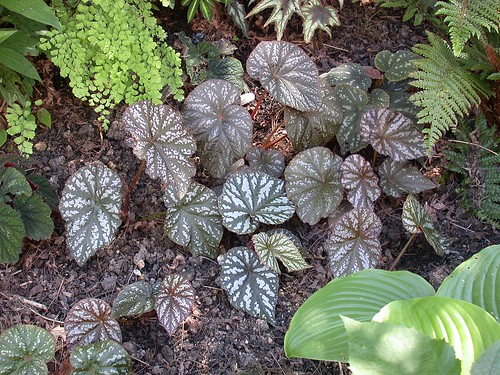
B. grandis × U489 seedlings in the garden (May 2012)
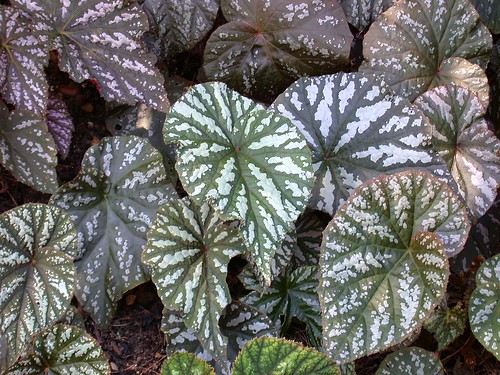
B. grandis × U489 seedlings in the garden (June 2012)
And then came July. Washington, DC had a record-breaking heat wave in 2012 with an extended period in the high 90's and several days in the low 100's. This was simply too much for many of my begonias. The seedlings from this cross didn't melt outright as some of my other begonias did, but after the heat wave they looked terrible. I might have forgiven that, except that they didn't put out much new growth after that; the initial flush of gorgeous spring foliage seemed to be all they had in them. I've discovered this problem with several of my B. grandis hybrids: they put out beautiful foliage in the spring, but stop producing new growth by mid-summer. Without new foliage to replace it, the old foliage looks increasingly tired and tattered as summer wears on.
Even then, I might have forgiven this one delectable seedling its faults, but it still had one last test: winter. When fall and freezing temperatures came I left all the seedlings from this cross in the ground, mulched them, and crossed my fingers. This is the test all my begonias get, because I want to identify the hardiest plants to breed with, and don't want to produce beautiful delicacies that need to be coddled! I'd already had surprisingly good results from another cross so I thought my chances were pretty good with this one.
This spring I anxiously waited for my various begonias to emerge. Many of them did, including species and hybrids that I hadn't expected to survive, certainly helped by a warmer-than-average winter. Finally, I saw growth emerging from one of the B. grandis × U489 seedlings. Then another, and another. In total, about half of them had survived... but the best seedling, the one I started this blog post lamenting, wasn't among them. I waited all summer, hoping it would eventually re-emerge from some little bit of rhizome left alive underground, but it was gone. After insufficient heat tolerance, and failure to produce new growth after early summer, lack of hardiness was the third strike and it was out!
The next-best seedling from the same cross likewise didn't survive, but had had the same issues. I allowed the surviving siblings to grow again this year, but although they held up better through a more typical Washington, DC summer their foliage isn't nearly as nice as the ones I lost and none of them are as vigorous as I would like. These seedlings are now going into their second winter but I probably won't name or release any of them, unless one of them not only survives another winter but really impresses me next year.
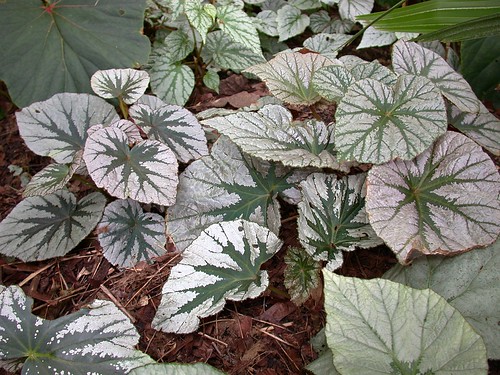
B. grandis × U489, surviving seedlings in September 2013
Although my long-term goal is to breed hardy begonias, with many of my crosses I'm finding lack of heat tolerance and poor summer performance to be the bigger issue in the short term. Many gardeners are willing to grow a plant for a single season as long as it grows well and looks nice--this is the basis of our entire annual plant industry! But no matter how beautiful, if it collapses or looks tired in the summer, it's just not worth growing, even if it's likely to survive the winter.

Wow!!! Really great post!! Super nicely documented!
ReplyDeleteDo you regret not propagating it before you tested it? I'm definitely interested in tolerance as well...but if I thought some Anthurium leaf pattern was nice enough...then I probably would have propagated it before testing its limits. And a begonia is far easier to propagate than an Anthurium (unfortunately!).
Regarding lack of heat tolerance. Kartuz recently e-mailed me a link to an issue of International Rock Gardener (PDF). It has some really neat plants...including a couple of those awesome epiphytic Gesneriads from Chile (Sarmienta, Asteranthera, Mitraria) that I would love to try and grow. The title of his e-mail..."We can't grow these"...hehe. Kartuz says that they can't handle our SoCal heat but that they grow great up in San Francisco. He's probably right but I'd sure love if he was wrong!
So personally, if I had created a Begonia as beautiful but heat intolerant as yours...then I probably would have sent it to my friend Dan Newman (Hanging Gardens) in Pacifica (it's just South of San Fran on the coast). I would also have given it to my friend Dan Yansura who also lives in Pacifica. Newman has a greenhouse full of some of the neatest plants...mostly orchids and mostly cool growers...but with some other gems mixed in. Yansura has the largest collection of tree ferns that I've ever seen...around 20 or so different species all outside year around. So so amazing to see such a wide variety of tree ferns happily growing outside year around up there...many of them from unlikely countries. Right now Yansura is in Burma with some of our other friends in the LA Fern Society! I'm so jelly!!!
I'm sure that both Newman and Yansura would have really enjoyed your beautiful Begonia...and I'd be surprised if it wouldn't have thrived in their cool coastal conditions.
Of course I'm not saying that sharing it with errrr..."cooler" friends is what you should have done...I'm just saying that it's something that I probably would have done. I guess it's just something that's worth the effort for me to share with you...to perhaps keep in mind for future reference.
Are you going to keep trying the cross? The more times you try it...the greater the chances that you'll get an individual that has the best of both worlds...right? There's certainly an opportunity cost though.
Hi John . . . nice attempt and you are to be congratulated for incredible self-discipline to stick to your standards. One question . . . did you do the cross in both directions. It might make a difference in cultural characteristics. Good luck!
ReplyDeletePaul in Sacramento
Thanks guys!
ReplyDeleteXerographica: My attitude is that there are already lots of (I would say too many) beautiful rex and rex-like hybrids out there--many good ones, but some not-so-great ones and many that just require too much fussing. I don't want to contribute to that mess unless I can come up with something truly different and distinct, as well as (relatively) easy to grow. Most of all I want to develop bedding (or possibly container) plants for the east coast, to be grown outdoors rather than as houseplants. There are already plenty of begonias well-suited to areas with cooler summers; heat tolerance on the other hand is something that is sorely needed, in cultivars that are not truly tropical (which often require more consistent moisture, humidity and warmth--most of these are best as terrarium or greenhouse plants). Finally, I'm trying to interest some commercial growers in my hybrids, and that means producing plants of the highest quality.
Paul: I didn't try it but wouldn't expect the reciprocal cross to give me any different results. Ideally, I should have grown out several hundred (or even thousand) seedlings and then I would almost certainly have gotten the right combination of attractive foliage, vigor, and hardiness. Sad to say I just don't have that kind of space (or time)!. I have several hybrids from other crosses coming that have promise, but I will certainly use U489 in future crosses to try to re-capture that great leaf pattern. (I could go on, but I don't want to give away too many secrets!)
My friend Mimi Fleurs just shared this blog entry with me. She's the Begonia queen of SoCal and is largely responsible for getting me far more into Begonias since I first commented on this entry.
DeleteRight now I have a very nice pod developing on my Begonia burkillii silver edge from pollen of a random rex with white and pink leaves. Have you ever seen a burkillii crossed with a rex? I haven't.
If I get any seedlings, I'm pretty sure that none of them would be able to grow outdoors year around in your neck of the woods. But this doesn't necessarily mean that my seedlings can't be indirectly useful to you.
My seedlings can potentially facilitate the Begonia colonization of California, which in turn facilitates the Begonia colonization of marginally colder/hotter states, and so on.
Colonization is a function of mass. More Begonia mass, more Begonia colonization. Yes, the mass is a mess, in the sense it's a very mixed bag, but the bigger the bag, the more beautiful outliers, and the faster the colonization.
If you visit SoCal you could spend weeks seeing different gardens with plenty of Begonias. But if you walked around a random neighborhood, I doubt you'd spot many, if any, Begonias, which is a real shame. We need a much bigger bag of Begonias.
Thanks John, I really enjoy reading your posts!
ReplyDeleteThanks Rick!
DeleteSo, is it possible to get starter piece of B. grandis × U489 at the stage it is at now? Just asking, the plant is so beautiful. I like unusual hands on creative hobbies. I have maybe 50 begonias. Canes and Rhiz. two Rexes.
ReplyDeleteThe seedling in the top photo above is long gone and I am not naming or distributing any of the other seedlings from this cross. They are simply too badly flawed, including the ones that survived (although after this past winter, I'll be amazed if any of them come back at all).
DeleteJohn, I just wanted to say thank you for sharing about what it took to cross
ReplyDeleteB. grandis × U489. Sometimes we have to step away from a project then come back to it. Well, hopefully you will pict it up again down the road. I meant starter plant not piece.
John, keep up the great work. I can hardly wait to try some of your begonias here in NJ. You are really doing a service to all of us plant nerds. Thanks.
ReplyDeleteDid any of the seedlings produce aerial bulbils as does B granis?
ReplyDelete